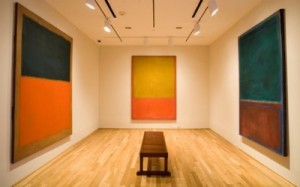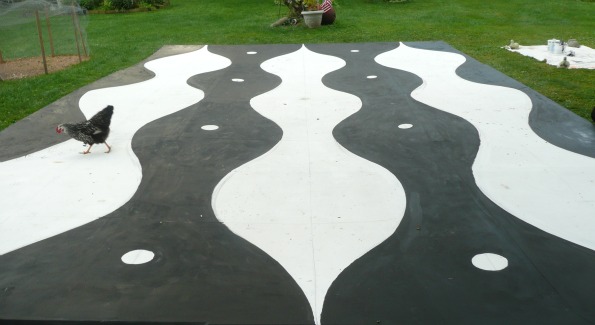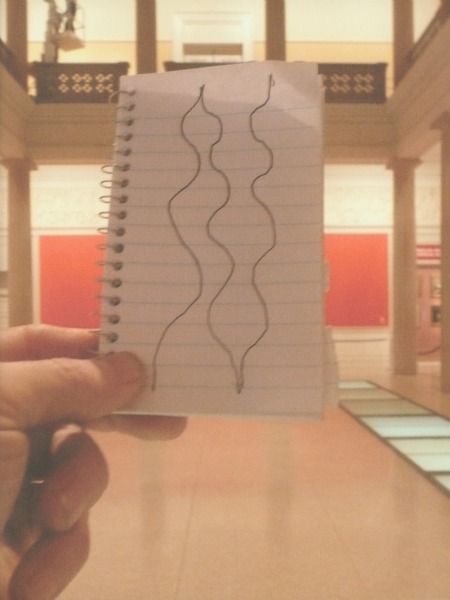With glitter, feathers, bread, Persian rugs, and 26-foot canvases, Chris Martin has people talking about his one man exhibit “Painting Big” in the Corcoran Gallery.
By Shannon O’Reilly

Installation view of Chris Martin: Painting Big, 2011. Corcoran Gallery of Art, Washington, D.C., Photo by Denny Henry.
For most artists, their tools are strictly paint and brushes but for Chris Martin everything has a potential for art, from a slice of bread to a throw pillow to a kitchen sponge. The everyday serves as an inspiration for the quirky, and at times mind boggling, paintings that Martin creates. In a visual roller coaster of lines and shapes, Chris Martin presents his unique perspective on life in an expansive three-room exhibit titled “Painting Big,” at the Corcoran Gallery of Art.
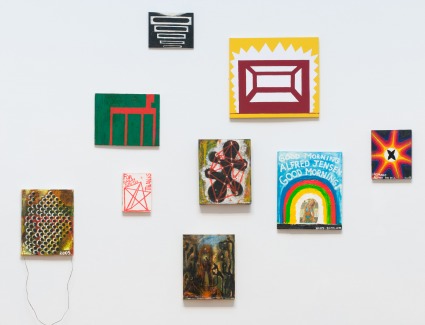
In the Corcoran's Rotunda is a collection of small paintings and collages spanning Martin's career from 1980. Corcoran Gallery of Art, Washington, D.C., Photo by Denny Henry.
The first room in the exhibit consists of three 26-foot-tall canvases commissioned specifically for the atrium space. The canvases are overwhelming, creating a visual dimension that the Corcoran calls “a nineteenth-century vision of democratic space.” The Corcoran’s Rotunda features an assemblage of smaller paintings from the last 25 years and the Corcoran’s NOW gallery shows a focused selection of six large-scale paintings on the subject of landscape produced between 2002-2010.
So who is this artist that boldly pastes slices of bread to plywood or creates a 26-foot black and white designed canvas with bird droppings in the corner and footprints of a chicken running across the wavy white lines? Behind the artist is a man with a rich upbringing that began where his first one-man exhibit is currently taking place, in Washington, D.C. The city is famous for two main things: its politics and its art. Both of these qualities played an important role in the development of Martin as an artist.
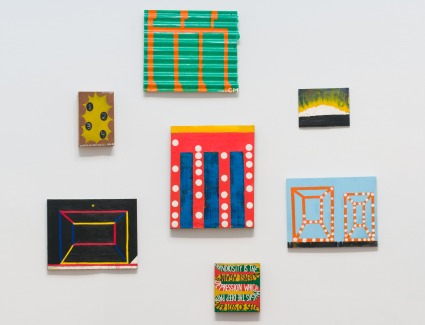
The 25 paintings in the Corcoran's Rotunda showcase Martin's experimentation with abstraction and perspective. Corcoran Gallery of Art, Washington, D.C., Photo by Denny Henry.
When it comes to D.C. politics, Martin remembers the political demonstrations and the riots. The African American radio and Martin Luther King’s speech, which occurred when he was 10, served as highlights for his developing spectatorship on culture and the political dynamics of the country. For Martin as a child, “it was exciting to be around that in D.C.”
As for art, the plethora of free art museums that permeate the Capitol City served as an art oasis for meditation and inspiration. Martin remembers vividly visiting these museums, especially the Corcoran, where his exhibits now fill the space. His favorite space though was the Phillips collection, specifically the Mark Rothko room, one of the great masters that have impacted his work.
The Rothko room contains three large paintings, each canvas broken up by two large blocks of color. For Martin, these bring out an essence of landscape, specifically fields growing with color. “It’s a nice, special place,” Martin accounts. “That room inspired me to particularly make the three paintings in the Atrium.”
Other master artists that serve as inspiration are Robert Rauschenberg and Jasper Johns, both famous in the late 50s and 60s for painting real life with humor.
“It’s important when you make things you can be funny,” said Martin.
And that’s just what he does. Martin takes his love for landscape and makes it something completely his own. As a young painter, his favorite things to paint were trees and roads. As he grew as an artist and moved toward abstraction, Martin explains, “I never lost my interest in landscape,” which can be seen subtly through out the exhibit in the titles of the works and in the forms and shapes that traverse his canvases.
“The leap that I made was instead of just using typical art supplies I started looking around my house and using things that I thought were cool, weird, funny and beautiful. I was using things like glitter and feathers. I would see a photograph or a newspaper clipping and put it into a painting. It was fascinating to me,” said Martin.
With household objects in hand, Martin brought to life his memories of his time in the Catskill Mountains and travels in India, through the lens of abstraction. For, the paintings about India and the Catskills, he consciously wanted to make them about his experiences. For the most part these references are not specific and require a keen eye and an open mind. Martin compares his approach to a piece of music that doesn’t have words. He explains, “It doesn’t sound exactly like the waves of the ocean but evokes for you the artist the landscape.”
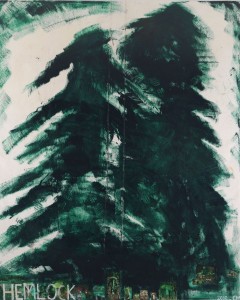
Chris Martin, Hemlock, 2010. Oil, gel medium, and collage on canvas, 135 x 118 in. Courtesy of the artist and Mitchell-Innes & Nash, New York.
Hints of the Catskills can be seen with the use of the color dark green, which for Martin evokes pine trees. The painting “Hemlock,” most closely resembles the imagery of pine trees. Two large dark forms cover the large-scale canvas. The initial structure resembles a tree but as the branches extend outward the brush stokes become chaotic. Martin adds more quirks with green shoe prints at the end of brush strokes and newspaper clippings of mushrooms lining the bottom. India, specifically the Ganges River, is represented in shades of blue and curves, like the form of a lake. In the paintings “Staring into the Sun” and “Ganage Sunrise Asi Ghat Varansi…” colors are bold and the lines are blunt. Blue makes a guest appearance in both paintings but the harsh lines and colors that surround it turns Martin’s view of a sunrise into something unexplainable and impossible to grasp.
Martin is consistent in his art when it comes to experimenting with abstraction and perspective. The incorporation of household items turns the usual into the uncanny. What does it mean when Martin paints a rainbow, pastes a picture of a women in a bikini underneath, and titles it “Good Morning Alfred Jensen?” How does one interpret a 26-foot canvas painting covered in glitter, newspaper, pictures, and chandelier crystals?
For Martin, there is no true meaning behind his work. Instead, he explains the painting’s purpose is “what pops into your mind.”
“I hope when you look at the paintings you wake up in someway. You get pleasure and it brings back some memories for you,” said Martin.
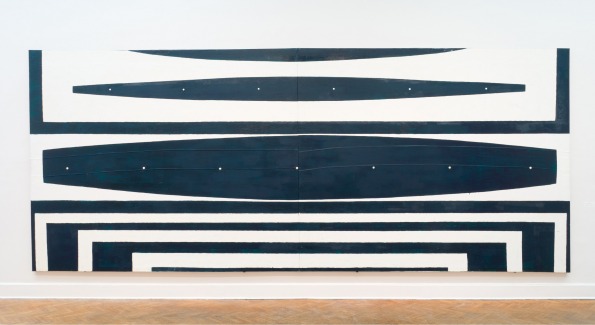
Chris Martin, Lake, 2002–2005. Oil on canvas, 118 x 286 in. Courtesy of the artist and Mitchell-Innes & Nash, New York. Photo by Denny Henry.

A look at the Corcoran's Rotunda, featuring the abstract paintings by Chris Martin. Photo by Denny Henry, courtesy of the Corcoran Gallery of Art.

